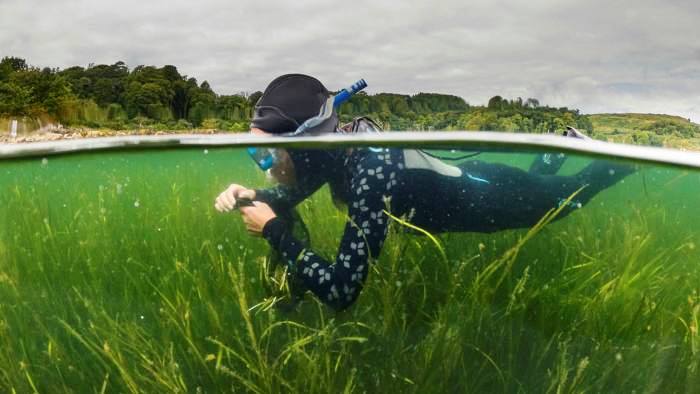If you’re a long-time reader of REVITALIZATION, you’re no doubt familiar with the concept of rewilding: ecological restoration that goes beyond restoring specific functions or species to actually restore systemic “wildness.” You’ll also know that, while the concept was first proposed here in the U.S. by conservationist Douglas Brower, the United Kingdom—Scotland in particular—has emerged as the global rewilding leader.
Now, the cleverly-named Scottish non-profit, Seawilding, has expanded both the concept and the practice to included coastal marine ecosystems. Their community-led work is restoring both oysters and seagrasses, two of the most essential keystone species that lay the foundation for restoring other plant and animal species, not to mention revitalizing fishing economies.
Native oysters were once common in many sea lochs, but owing to human predation and pollution, they’re now very rare. They filter and clean the water and form complex 3D reefs which become fish spawning and nursery grounds. By developing low-cost methodologies to help restore the degraded inshore marine environment, Seawilding hopes to roll-out its projects to other coastal communities.
Community snorkelers and volunteers marked a milestone in Scottish inshore marine habitat restoration during Seawilding’s seagrass harvest open days on August 21 and 22, 2021 by harvesting and planting seagrass in Loch Craignish.
Over 60 snorkelers and volunteers from the Craignish Peninsula, students from Scottish Association for Marine Science (SAMS) and volunteers from across Scotland took part in the project which aims to extend an existing seagrass meadow by a quarter of an acre.
Seawilding has partnered with Project Seagrass and SAMS to deliver Scotland’s first community-led seagrass restoration project. Seawilding and members of the Craignish community are running it, while Project Seagrass provides technical oversight and SAMS, environmental monitoring and environmental DNA sampling.
Seagrass (Zostera marina) is a vital inshore marine habitat, which sequesters carbon faster than a rainforest and turns bare sand habitat into a structurally complex, productive ecosystem full of marine life.
It’s also a key nursery ground for commercially important fish species such as cod, pollack, whiting and plaice, as well as herring and sea bass. Up to 92 per cent of seagrass meadows have disappeared around the UK coastline.
At Loch Craignish, there are ten small degraded meadows and the project, funded by NatureScot’s Biodiversity Challenge Fund, aims to enhance the existing meadows this autumn, while trialing different restoration methodologies. If successful, the Seawilding team plan to roll out the methodology to other coastal community groups to help them restore seagrass in their local sea areas.
During the weekend, community volunteers learned about the incredible “eco-services” of seagrass, snorkeled through the seagrass meadows, harvested the seed by hand, processed it at Seawilding’s on-site facility and planted 10,000 seeds in small hessian bags which give the germinating plants purchase on the seabed.
“It’s been a very exciting weekend and a real eye-opener for so many to get in the water and see for themselves the wonders of the seagrass meadows” said Danny Renton, Seawilding’s CEO.
“Community-led initiatives like these are a really important first step in our efforts to restore the health of the inshore marine environment which has been hammered by over-fishing, scallop dredging and bottom trawling, and pollution from aquaculture. It’s very empowering for community volunteers to get into the water and make an active difference to restore lost bio-diversity. It’s onwards and upwards for us,” he added.
Seawilding is working with communities to restore the keystone species, native oysters and seagrass, to Scottish inshore waters in order to restore bio-diversity and sequester carbon. They plan to restore 1 million native oysters to Loch Craignish over the next five years and has already introduced nearly 250,000.
Featured photo courtesy of Philip Price / Seawilding.

